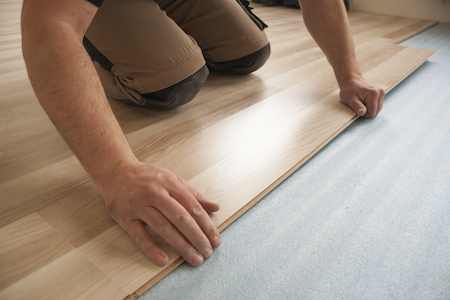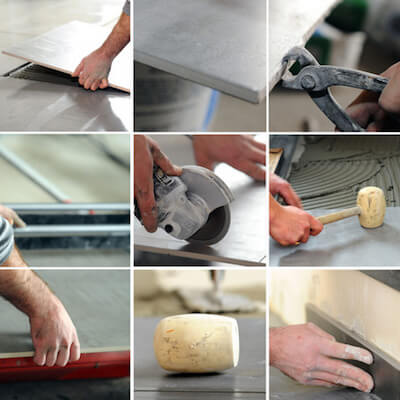Want Affordable Flooring? Take a Look at Floating Floors
Sometimes the easiest way to change the look of your decor is to start with one project at a time. With a coat of paint and new flooring, you’ll be surprised at how different your home will look.
Are you looking for a do-it-yourself project? Painting the walls is easy; you’ve probably done it a few times yourself. But flooring – that sounds a bit trickier. Is there an affordable flooring option that’s easy for do-it-yourselfers?
Do a little bit of research and you’ll quickly find the concept of floating floors. Is it the right choice to suit your needs?
What is a floating floor?
Floating floors aren’t a particular type of flooring. Instead, it’s a way of installing flooring. With most flooring, there’s a lot of prep work to ensure the flooring stays put. You’ll have to:
- Ensure the subfloor is even, clean, and dry
- Buy or rent necessary tools for installation
- Select the right adhesive
- Or learn to use a nail gun
- Ensure underlayment is in place
- Carefully install the new flooring
- Live with the consequences if any part of the process didn’t go as planned
That’s why many homeowners leave floor installation to the professionals.
But that didn’t take away the desire for a DIY project. And that’s where floating floors came into play. Floating floor floats above the flooring beneath it without having to be permanently attached. The planks or tiles click and lock together to create a solid flooring structure over the flooring beneath. It provides you with an easy way to have new flooring quickly, in an economical way.
 Because the floor isn’t nailed or glued down, each board is constructed in layers to add stability and strength. The top layer is the color or finish you’re looking for, while the layers underneath give it core strength and durability. And in some cases, water-resistance or even waterproof features.
Because the floor isn’t nailed or glued down, each board is constructed in layers to add stability and strength. The top layer is the color or finish you’re looking for, while the layers underneath give it core strength and durability. And in some cases, water-resistance or even waterproof features.
What finishes are available?
The good news is that floating floors have grown in popularity over the past few years. Today you’ll find floating flooring created from a variety of different materials. If you have a color, style, or pattern in mind, you’ll find it in a floating floor.
The basic floating floor materials include:
Laminate
This is by far the most popular floating floor. Laminate planks are designed to imitate the most popular hardwood flooring choices at a fraction of the cost. It’s easy to install, and provides good stain-resistance. However, if you’re looking for water-resistance, think twice before installing laminate. Laminate isn’t made for bathrooms or laundry rooms, and can quickly wear down from too many spills in the kitchen.
Engineered wood
While some people have problems with the sound and look of laminate, they may easily prefer engineered wood to create a more cohesive look. Engineered wood looks like traditional hardwood because it has a hardwood veneer as its top layer. Yet it’s priced lower and easier to install because it’s designed with several core layers that increase durability. Want a click and lock system for a DIY project? You’ll find many options with engineered wood. Because of its popularity, you’ll even find the latest trends, such as recycled or reclaimed hardwood.
Luxury vinyl planks and tiles
Luxury vinyl has been growing in popularity because of all it offers. Want marble flooring? Want hardwood? Love the look of natural stone, but don’t want the time or mess it takes for installation? Look at tile floating floors instead. This can be the perfect choice for areas where you want a little elegance, but might not be conducive for tile. Worried about a less-than-perfect subfloor? Floating floors won’t be impacted. Plus, floating tile flooring can be the perfect thing to install in your bathrooms over radiant heating. If you choose a brand that’s waterproof, it’ll last for years without giving up on its good looks.
Cork
Cork is increasing in popularity because of what it can add into your home. Want something that absorbs sound? Want something that’s soft underfoot? You’ll love what cork has to offer. It’s also popular because it’s natural and offers sustainability improvements to your home. Install cork flooring, and you’ll feel the difference right from the beginning.
Tile
Some homeowners love the look of tile, but don’t want the mess that normally comes along with it. If that describes you, you’re in luck. Floating tiles look and feel like their counterparts, but they are easier to install than conventional tiles. You won’t need mortar. They come with automatic tile spacing guides, so you won’t have to worry about spacing problems. Pricing may be a little higher than traditional tiles; go with a cheaper option, and you may pay the price with an inferior product. But if you want a DIY approach with the classic good looks of tile, this may be the right choice.
Are floating floors the right choice for you?
If you’re looking for an easy floor to install, whether you’re doing it yourself or hiring a professional, floating floors ensure you’ll have a quality floor installed in less time. The interlocking system means there’s no fuss with getting the subfloor perfect, adding adhesive, or nailing the flooring in place.
What’s more, fixing problems is easy too. Invest in extra flooring and if you have a problem – a spill, a stain, a dent, or a scuff – you simply remove the old boards and replace them with new. This can eliminate the need of having to replace the entire floor for one damaged floorboard.
Floating floors are also less expensive than other flooring options, meaning you’ll be able to replace or remodel without having to worry about the cost.
And if you’re looking for style, color, or pattern choices, you’ll be amazed at your options with floating floors. In many cases, the color ranges extend way beyond what you’ll find with traditional products.
If you want water-resistant, stain-resistant, or even waterproof flooring, the options are almost endless in floating floors.
Want to view all your options? Stop by today.

